Charles L. Hutchinson
Charles Lawrence Hutchinson (March 7, 1854 – October 7, 1924) was a prominent Chicago business leader and philanthropist who is best remembered today as the founding and long-time president of the Art Institute of Chicago.
Charles Lawrence Hutchinson | |
|---|---|
_of_Charles_L._Hutchinson%2C_(1890-1924)%2C_by_the_artist_Gari_Melchers_(1860-1932)%2C_apf1-05179.png) Photographic image of a painting of Hutchinson by the artist Gari Melchers | |
| Born | March 7, 1854 |
| Died | October 7, 1924 (aged 70) Chicago, Illinois |
| Occupation |
|
| Spouse(s) | Frances (née Kinsley) Hutchinson (1857–1936) |
| Parent(s) | Sarah (née Ingalls) and Benjamin P. Hutchinson |
Background

Hutchinson was born in Lynn, Massachusetts in 1854 to Benjamin P. Hutchinson (1828-1899)[3] and Sarah (née Ingalls) Hutchinson (1833-1909), and relocated with his family to Chicago in 1856 after a brief stay in Milwaukee. In Chicago Benjamin Hutchinson founded Chicago Packing & Provision Co., which for many years was the leading meat processor in the United States.[4] In 1863 he became one of the first directors of the First National Bank of Chicago[5] and in 1881 founded the Corn Exchange Bank[6] (with subsequent mergers and acquisitions now Bank of America)[7] and as a member of the Chicago Board of Trade was known as one of the city’s wealthiest and most colorful speculators.[8] Charles graduated from the Chicago public schools in 1872 and entered the business world as a clerk in his father's office, becoming a junior partner with his father in 1875 in the firm B.P. Hutchinson and Son., commission merchants.[9] Although he never attended college, he was a founding trustee[10] and the first treasurer of the University of Chicago,[11] positions he held until his death. He married Frances Angeline Kinsley, daughter of Herbert Milton Kinsley, on May 26, 1881.[12] Herbert Kinsley had, in the last decades of the 19th Century, become one of Chicago’s premier caterers and restaurateurs after having made his reputation during his peripatetic career in part by hosting a ball for the Prince of Wales at the Anglo-American Hotel in Hamilton, Ontario Canada.[13]
Because of his contributions to the world of philanthropy, art and education Hutchinson was twice awarded honorary degrees by what is today Tufts University, the first one a being a Master of Arts in 1901,[14] and the second one an LL.D in 1920.[15] Hutchinson was also the recipient of an honorary Master of Arts degree by Harvard University in 1915.[16] For his service as consul general for Greece in Chicago[17] during the World's Columbian Exposition,[18] Hutchinson was awarded the Badge of the Order of the Redeemer by King George I of Greece in 1908.[19] He was granted a knighthood by King Albert I of Belgium in 1919 for his work with the Belgian Relief Committee during World War I,[20] and was a supporter of the founding of the League of Nations at the war's end.[21]
Hutchinson served as Chairman, Committee of Fine Arts for the World’s Columbian Exposition of 1893.[22]
The Art Institute of Chicago
"Established in 1879 from the remnants of a foundering art academy, the Art Institute of Chicago grew into a sturdy organization largely through the efforts of ... Hutchinson, who served as its president from 1882 to 1924."[23] Although Hutchinson’s personal wealth was generated thru banking, grain speculation and meatpacking enterprises that his father had established after coming to Chicago in 1856, Charles L. Hutchinson’s “greatest enthusiasm was for art and the establishment and growth of the Art Institute”.[24] Founded on May 24, 1879[25] as The Chicago Academy of Fine Arts; The Art Institute assumed its present name in 1882.[26] Hutchinson was a founding trustee of the Chicago Academy of Fine Arts, and recognizing his energy and vision, was named by the board of trustees as its first president three years later when it was renamed the Art Institute of Chicago. As one of many accolades conferred on Hutchinson by the Art Institute, the trustees passed a resolution On October 22, 1907 dedicating Gallery 32 as the Charles Lawrence Hutchinson Gallery of Old Masters to commemorate Hutchinson’s twenty-fifth anniversary as president of the institution.[27] After he died in 1924, his obituary notice in The Bulletin of the Art Institute noted that “His entire life was devoted to public service, but his service to the Art Institute was so intimate, his devotion so complete that it is not possible to measure it. He was The Art Institute, and it will stand as his most permanent monument”.[28]
The Art Institute on the move
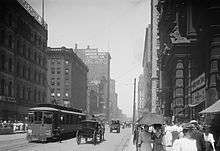
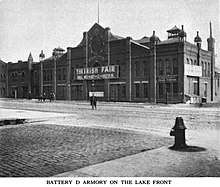
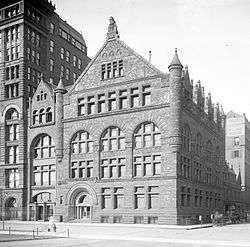
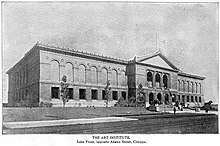
Charles L. Hutchinson saw the Art Institute thru every move and building program from the time of its founding until the time of his death in 1924. The institution’s first headquarters were located in Pike's Building at 170 State St.[33] in the rooms of the recently defunct Chicago Academy of Design. They remained there until May 1 of 1882, when Hutchinson recognized that the growth of the organization required a larger facility that featured more artist-friendly accommodation. At that time the group relocated to rooms on the second floor of the D Battery Armory on Michigan Avenue[34] (located just north of where today the Allerton Building of the Art Institute is located). The drive for what was intended to be a permanent facility also began that year when Hutchinson acquired a lot at the southwest corner of Michigan Avenue and VanBuren Street that had built on it a two-story commercial building that was leased in part to a medical college, for which he advanced the Art Institute the purchase price of $45,000.[35] The Art Institute moved its offices into the vacant part of the building,[36] and subsequent to the purchase a three-story addition of pressed brick was built on the back portion of the lot. Classes moved from the armory into this new space on January 8, 1883 [37] and these accommodations remained the extent of the Art Institute's real estate holdings until 1885, when the lot to the immediate south was acquired for expansion. Because of the organization's continued rapid growth the medical college building was demolished in 1885 and a new building by John Wellborn Root was built around the 1882 structure to provide more classrooms, galleries and museum space, with a portion of the building set aside for artistically-oriented tenants and organizations whose rent was intended to help pay for the new building and its operations.[38] Contemporary news reports credited the efforts of Hutchinson as being the drive behind the construction of the new building and “the one man to whom the Art Institute owes its splendid status”.[39]
Under Hutchinson's watch, plans for expansion of the museum's collection and the building program continued unabated. He used his influence as an organizer of the World's Columbian Exposition to acquire property for a new building for the Art Institute on the east side of Michigan Avenue in Lake Park (today Grant Park) on landfill that had been created with debris from the Great Chicago Fire. On this property was then located a structure that was initially designed and built as a conference center for the fair, but that afterwards became the new home of the Art Institute. It was intended that proceeds from the sale of the VanBuren Street building and $200,000 from the directors of the fair would provide the Art Institute with "a permanent home for art works which will eclipse everything in the nature of fine structures Chicago has known hitherto".[40] This new structure (now the Allerton Building) replaced the Exposition Building (built in 1873) that was standing on the site, and was designed by Shepley, Rutan and Coolidge, the later of whom was a friend of Hutchinson's having been the architect of Hutchinson Hall at the University of Chicago (1890). The Art Institute moved into the new structure in November 1893 after the fair closed, and Hutchinson spent the next several years leading the effort to reconfigure the interior of the new building. The work entailed the building of the Grand Staircase and the creation of space for the school, libraries, galleries, and the filling of that space with world-class art acquired locally or (more frequently) thru buying expeditions to Europe and Asia.
As the Art Institute was not able to provide Hutchinson with the generous purse that would be required for that purpose in those early days, this feat was effected thru Hutchinson's personal connections to Chicago's wealthiest families. An early coup in this regard for Hutchinson and Martin A. Ryerson, a fellow trustee and his frequent companion in these forays, was the 1889 purchase, "at great sacrifice" to the seller, of thirteen seventeenth century Dutch paintings that were purchased for $200,000, the money for which was advanced by Marshall Field, Philip Armour and others.[41] The New York Press sniffed at this effort in what was perceived as an example of Chicago’s cultural barbarism, considering the city’s position as hog butcher to the world and its philistine reputation as a resolute accumulator of wealth for its own sake by whatever means: “He (Hutchinson) probably paid $1,000 a front foot for them, and we assume the citizens of Chicago will give him a triumphal procession when they arrive, carrying them and him in huge floats, drawn by teams of milk-white Berkshire hogs that have been newly washed with a ten inch hose jet of water until their pink flesh shows under the clean bristles.”[42] Hutchinson's connections would serve the Art Institute well over the next few decades. Among the notable additions to the museum's collection acquired through them included bequests by Bertha Palmer, Martin L. Ryerson and Clarence Buckingham, whose gifts would add resources which respectively formed the basis of the museum's notable Impressionist collection and augmented other collections with more than two hundred additional Old Master, Impressionist, and Post-Impressionist paintings and 1,400 Japanese woodblock prints.[43]
In 1912 a bridge was built to span the by-then suppressed tracks of the Illinois Central Railroad that ran immediately behind the 1893 building, and in 1916 a two-story structure was built on top of it, funded with a $50,000 donation made by railroad inventor William H. Miner. This structure was named Gunsaulus Hall to honor Frank W. Gunsaulus, museum trustee and the first president of the Armour Institute, and housed the museum's industrial arts and related media collection [44] (the Alsdorf Galleries today occupy the first floor of that space). By 1920 there were talks in earnest regarding the addition of McKlintock Court and the Hutchinson Wing which surrounds it and the Goodman Theater/Goodman School of Drama, which was a gift of the family of the playwright Kenneth S. Goodman, who died in 1918. Ground for the building of the latter pair (by Howard Van Doren Shaw) was broken in 1923 [45] and the theater opened to the public in 1925.[46]
Affiliations
Hutchinson believed that a man’s secret of success lie not only in “intense industry”, but also in “his recreations [that] make or break him as surely as do his business habits”.[47] Over the course of his lifetime, Hutchinson was president, board member, trustee and/or supporter of perhaps as many as seventy commercial, civic and philanthropic institutions. Among those were included:
Business/Commercial
- Chicago Board of Trade, president[48]
- Chicago City Railway Co., director[49]
- Commercial Club of Chicago, President, Vice-President, Treasurer[50]
- Corn Exchange Bank, president[51]
- Northern Trust Bank, director[52]
- State Bank of Chicago (after mergers Chase Bank), founding director,[53]
- Western Stone Company, director[54]
Civic
- Chicago Auditorium Association, director, secretary[55]
- Chicago Opera Association, treasurer[56]
- Chicago Sanitary District, treasurer.[57]
- Chicago Symphony Orchestra, trustee[58]
- Citizen’s Association of Chicago, treasurer[59]
- Civic Music Association of Chicago, treasurer[60]
- Fine Arts Committee, The World’s Columbian Exposition, chairman and director[61]
- Horticultural Society of Chicago (now the Chicago Horticultural Society), director[62]
- Illinois Committee on Social Legislation, treasurer[63]
- Republican Sanitary District Convention, delegate[64]
- South Parks Commission, commissioner[65]
- World’s Columbian Exposition, committee of 100[66]
Educational
- American Federation of Arts, founding president[67]
- Art Institute of Chicago, trustee, president[68]
- Carnegie Institute of Washington, trustee[69]
- Chicago Manual Training School (University High School), treasurer [70]
- Chicago Public Library, director[71]
- Egypt Exploration Fund, vice-president[72]
- Municipal Art League, treasurer[73]
- National Art Association - Smithsonian Institution, vice-president[74]
- National University, trustee[75]
- University of Chicago, trustee, treasurer[76]
Religious
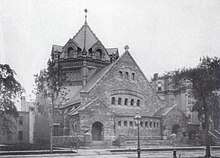
- St. Paul's Universalist Church, Sunday school superintendent,[79] president
Philanthropic/reform
- American Vigilance Association, executive secretary and general counsel[80]
- Chicago Nursery and Half-Orphan Society, president[81]
- Chicago Orphan Asylum, president[82]
- Chicago Peace Society, treasurer[83]
- Hull House, director, treasurer[84]
- Illinois Society for Mental Hygiene, treasurer[85]
- Illinois Society for the Prevention of Blindness, president[86]
- Immanuel Woman’s Home Association, treasurer[87]
- Immigrant’s Protective League, treasurer[88]
- Oakhaven Old People’s Home (now Smith Senior Living), Committee of 100[89]
- Old People’s Home of the City of Chicago, trustee[90]
- Presbyterian Hospital, trustee[91]
- Rush Medical College, treasurer[92]
Miscellaneous
- Cliff Dwellers Club, founder, treasurer[93]
Death
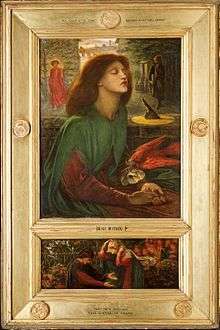
The Art Institute was never far from Hutchinson’s mind, and on his deathbed he was heard remarking to a friend “I love to lie here and think of it -- of all it will do for the people in the years to come!"[95] He died at Presbyterian Hospital in Chicago on October 7, 1924 after a brief attack of bronchial pneumonia, at which time he was remembered for the “many official positions [he held] in charitable, philanthropic and educational bodies.”[96] His will provided for generous donations to be made to the Art Institute, including twenty paintings from his private collection[97] including those by:
- Rossetti (Beata Beatrix, 1871/72)
- Maes (Portrait of a Woman and Portrait of Pierre Corneille)
- Jacob Gerritsz. Cuyp (Self-Portrait)
- Corot (Farm at Seine-et-Oise)
- Daubigny (Bords de l’Oise à Anvers)
- Palamedes (Portrait of Jan Miclasz Gael)
- Watts (Time, Death and Judgement and Portrait of Joachim)
- Leys (Rembrandt's Studio)
- Ranger (Noank Shipyard and Brooklyn Bridge)
- Dupré (Cows in Stream)
- Fromentin (Arab Boys at Play)
- Teniers (Man Lighting a Pipe)
- Dias (Wood Interior and Forest Pool)
- Caspar Netscher (Lady at the Mirror)
- Aert van der Neer (Winter Sports on the Schie River)
- Hals (Portrait of Willem Van Heytheysen),
as well as a cash bequest in the amount of $95,000 (c. $1,326,000 in 2015).[98] Hutchinson is buried at Chicago's Graceland Cemetery.[99]
References
- "NO CONTEST HERE – A Rousing Majority Given Charles L. Hutchinson for President of the Board - The Largest Vote Ever Cast in the History of the Organization - Ballots Dropped Quietly and Steadily – What May Be Expected of the Winner – ALL RECORDS BEATEN". The Daily Inter-Ocean. XVI (289): 8. January 10, 1888.
- Hilliard, Celia (2010). "The Prime Mover - Charles L. Hutchinson and the Making of The Art Institute of Chicago". Museum Studies (Chicago). Chicago: The Art Institute of Chicago: 51–52. ISSN 0069-3235.
- "HUTCHINSON IS DEAD – Famous Board of Trade Operator Dies at Lake Geneva – FAILURE OF HEART – End is Hastened by an Attack of the Grip – Noted as one of the most Famous Men in the Financial History of the City". The Daily Inter-Ocean. XXVII (358): 3. March 17, 1899.
- Grossman, James R.; Durkin Keating, Ann; Reiff, Janice L., eds. (2004). The Encyclopedia of Chicago. Chicago: The University of Chicago Press. p. 971. ISBN 0-226-31015-9.
- Sperber, Jonathan (2005). The First National Bank of Chicago - Charter Number Eight - A brief history of its progress from the day it opened for business, July 1, 1863, to the same date half a century later, etc. Cambridge: Cambridge University Press. pp. 68–69 et al. ISBN 0-521-83907-6.
- Andreas, Alfred T., ed. (1886). The History of Chicago from the Earliest Period to the Present Time in Three Volumes - Volume III - From the Great Fire of 1871 to 1885. Chicago: The A.T. Andreas Company. p. 441.
- "THE GREAT SPECULATOR FAILS – Mr. Hutchinson Leaves Chicago and his Trades Closed Out". The New York Times. XL (12, 379): 1. April 30, 1891.
- Special Dispatch for the Chronicle (April 30, 1891). "OLD HUTCH FAILS – He Suddenly Leaves for Florida – All His Margin Accounts Closed Out – A Flurry in Chicago but no Failures – The Veteran Speculator Insane". The San Francisco Chronicle. LII (105): 1.
- Ingham, John N. (1983). Biographical Dictionary of American Business Leaders, H-M. Westport, Connecticut; London, England: Greenwood Press. p. 650. ISBN 0-313-23908-8.
- "UNIVERSITY OF CHICAGO – Men Who Will Act as Directors of the New University Here - Representative Chicagoans Who Are Among Those on the Board – It Is Said that Mr. E. Nelson Blake Will Be the President – THEY WILL MEET TO-DAY". The Daily Inter-Ocean: 5. July 9, 1890.
- "GIVES THEM A MILLION – Rockefeller's Additional Present to the University of Chicago – THE PRESENTATION LETTER – Directions of the Donor as to Its Expenditure – PROF. HARPER MADE PRESIDENT – He Is Given Six Months in Which to Accept the Honor – DETAILS OF ORGANIZATION COMPLETED". The Chicago Daily Tribune. L (CCLXII): 1. September 19, 1890.
- "Accessions – For the Museum". Bulletin of the Chicago Historical Society: 18. May 1925.
- Cropsey, Eugene H. (1999). Crosby's Opera House: Symbol of Chicago's Cultural Awakening. Madison: Fairleigh Dickinson Univ Press. pp. 376–377. ISBN 0-8386-3822-8.
- "Degree conferred upon Conger". The Daily Inter-Ocean: 9. June 20, 1901.
- "HOOVER ALUMNUS OF TUFTS – Awarded Degree at Commencement Exercises". Boston Post: 5. June 22, 1920.
- International News Service (June 24, 1915). "Harvard Makes M.T. Herrick LL.D". New Castle News: 2.
- Henschen, Henry N. (1905). A History of the State Bank of Chicago from 1879 To 1904. Chicago: Lakeside Press. pp. 22–23, 41.
- "BELOIT COLLEGE IN LUCK – Secures the Greek Exhibit at The Fair of Casts from the Antique". The Daily Inter-Ocean. XXII (249): 7. November 30, 1893.
- "Chicago Men and Women Honored by Kings, Queens and Emperors". The Chicago Sunday Tribune: 8. March 15, 1908.
- "U.S. Food Officials Decorated by Belgium". The Indianapolis Star: 11. May 1919.
- "First Step for World League by Chicagoans - President Lowell of Harvard inspires 500 to Plan to Impose Peace by Sword". The Chicago Sunday Tribune: 4. January 7, 1917.
- Cropsey, Eugene H. (1999). Crosby's Opera House: Symbol of Chicago's Cultural Awakening. Madison: Fairleigh Dickinson Univ Press. pp. 376–377. ISBN 0-8386-3822-8.
- Hilliard, Celia (2010). "The Prime Mover - Charles L. Hutchinson and the Making of The Art Institute of Chicago". Museum Studies (Chicago). Chicago: The Art Institute of Chicago: back cover. ISSN 0069-3235.
- "INVENTORY OF THE CHARLES L. HUTCHINSON PAPERS, 1868-1934". The Newberry Library. Retrieved 2015-09-17.
- "The Art Institute – The Western Art Movement and its Splendid Achievements in Chicago – The New Home of the Fine Arts – The Ward Collection – The Century, Harper's - The Formal Opening of the New Museum – The Loan Collection – A Noble Triumph". The (Chicago) Inter Ocean. XVI (239): 9. November 20, 1887.
- Zukowsky, John (1987). Chicago Architecture – 1872-1922 – Birth of a Metropolis. Munich, London, New York: Prestel. p. 8. ISBN 3-7913-2344-X.
- "The Charles Lawrence Hutchinson Gallery of Old Masters". Bulletin of the Art Institute of Chicago. I (1): 1. October 1907.
- "Charles Lawrence Hutchinson – 1854-1924". Bulletin of the Art Institute of Chicago. XVIII (9): 110. December 1924.
- Mack, Edwin F. (1914). Old Monroe Street : notes on the Monroe Street of early Chicago days. Chicago: Central Trust Company of Illinois. pp. 74.
- "Why Chicago Smiles - The Treasures of the Earth Pouring into Her Lap - She is Repeating the Progress of Venice, Culture Following Wealth - She "Gets There" with Equal Celerity as a Sea Port and as an Art Center". The York (PA) Daily. LXVII (6726): 3. June 17, 1892.
- Hogan, Erin (2009). The Art Institute of Chicago from 1879 to the Modern Wing. New York: Scale Art Publishers, Inc. p. 74. ISBN 978-1857595802.
- Hogan, Erin (1900). Twenty-first Annual Report of the Trustees for the Year Ending June 1, 1900 with Reports of the Treasurer, Director and Librarian, Catalogue of Members, List of Gifts, etc.; Together with the By-laws. Chicago: The Art Institute of Chicago. pp. 9, 19.
- "(classified advertisement ) Educational Directory – Art School". The (Chicago) Inter Ocean. IX (1 12): 1. July 31, 1880.
- "Art in Chicago -Studio and Gallery Notes". The Chicago Daily Tribune. XLI: 20. May 7, 1882.
- "Real Estate – A Fair Activity in Building Not Withstanding High Prices – Details of Mr. Pullman's Plan for a New Residence Suburb – It Will Have a Certainty of Rapid and Elegant Transit – Improvements at Woodlawn, Lake View, South Chicago and Elsewhere". The Chicago Daily Tribune. I (1): 9. July 23, 1882.
- Andreas, Alfred T., ed. (1886). The History of Chicago from the Earliest Period to the Present Time in Three Volumes - Volume III - From the Great Fire of 1871 to 1885. Chicago: The A.T. Andreas Company. p. 421.
- "Gossip of the Home Studios and Galleries". The Chicago Daily Tribune: 10. January 7, 1883.
- Hilliard, Celia (2010). The Prime Mover: Charles L. Hutchinson and the Making of the Art Institute of Chicago. Museum Studies (36.1). New York: The Art Institute of Chicago. pp. 23–24. ISBN 978-0-86559-238-4.
- "The Art Institute – The Western Art Movement and its Splendid Achievements in Chicago – The New Home of the Fine Arts – The Ward Collection – The Century, Harper's - The Formal Opening of the New Museum – The Loan Collection – A Noble Triumph". The (Chicago) Inter Ocean. XVI (239): 9. November 20, 1887.
- "Art Notes". The New York Times: 10. November 20, 1891.
- "FAMOUS PICTURES FOR CHICAGO - C.L. Hutchinson Tells How He Secured Gems from the Demidoff Collection". The Chicago Daily Tribune: 3. July 3, 1890.
- "Chicago Gets Some Corkers". The New York Press: 4. July 9, 1890.
- Art Institute of Chicago Museum Studies - Vol. 19 No.1 (1993). From the Archives: Photographs of the Art Institute of Chicago, 1893-1933. Chicago: The Art Institute of Chicago. pp. 12, 18.
- "Inventor Gives Institute $50,000 for Industrial Art - W. H. Miner Enables Construction of Hall to House Valuable Collection". The Chicago Daily Tribune: 1. November 6, 1915.
- "Ground Broken for Civic Theater in Grant Park". The Chicago Daily Tribune: 19. June 28, 1923.
- Christiansen, Richard (June 26, 1988). "Commentary - A Good Move - Goodman's relocation would benefit theater, city". The Chicago Tribune: M14-15.
- "How to Succeed". Chicago Livestock World. XIII (82): 8. March 18, 1912.
- "Hutchinson Chosen". The Decatur Herald. L: 1. January 11, 1888.
- "ANNUAL ELECTIONS – Chicago City Railway Company". The Daily Inter-Ocean. IX (252): 8. January 11, 1881.
- Farwell, John V., president (1908). The Commercial Club of Chicago Yearbook, 1908. Chicago: The Executive Committee. p. 23. ISBN 1333060742.
- "advertisement – Corn Exchange Bank". The Chicago Daily Tribune. L: 10. January 15, 1890.
- "advertisement –The Northern Trust Company Bank". The Economist: 125. January 25, 1902.
- Henschen, Henry N. (1905). A History of the State Bank of Chicago from 1879 To 1904. Chicago: Lakeside Press. pp. 22–23, 41. ISBN 1-164-11964-8.
- "The Western Stone Company". Stone – an Illustrated Magazine. X (3): 233. February 1895.
- "Chicago Auditorium Association". The Economist Investor's Manual: 68. May 1902.
- Langland, James (1920). The Chicago Daily News Almanac and Year-Book for 1921. Chicago: The Chicago Daily News Company. p. 873.
- Hutchinson, Charles L. (treasurer); Foot, Chas. A. (assistant treasurer) (1908). Proceedings of the Board of Trustees of the Sanitary District of Chicago. Chicago: Fred Klein Co. p. 232.
- French, Florence (June 1, 1922). "THE EVOLUTION OF AN ORCHESTRA – Chicago's Great Symphony Result of New York's Indifference – Theodore Thomas Originator, Frederick Stock the Progressive Follower – Extraordinary Development of Half a Century". The Musical Leader: 528.
- A Local List of Charitable and Philanthropic Organizations BELIEVED BY THE CHICAGO ASSOCIATION OF COMMERCE SUBSCRIPTIONS INVESTIGATING COMMITTEE TO BE WORTHY the SUPPORT OF THOSE WHO DESIRE TO FURTHER THEIR AIMS. Chicago: The Chicago Association of Commerce & Industry. 1915. p. 53.
- A Local List of Charitable and Philanthropic Organizations BELIEVED BY THE CHICAGO ASSOCIATION OF COMMERCE SUBSCRIPTIONS INVESTIGATING COMMITTEE TO BE WORTHY the SUPPORT OF THOSE WHO DESIRE TO FURTHER THEIR AIMS. Chicago: The Chicago Association of Commerce & Industry. 1915. p. 56.
- "Fair Plan Reaffirmed – The Electrical Layout of the Exposition Will Be Adhered to Exactly – Horticultural Chief Maxwell - Chief Putnam's Curios – Miss Couzins – The Ladies – Busienss of the Commissioner's Board of Control – Other Columbian Pointers". The Daily Inter-Ocean. XX (38): 68. May 1, 1891.
- "A Garden for June; Peony Show this Week". The Chicago Daily Tribune: 5. June 8, 1913.
- A Local List of Charitable and Philanthropic Organizations BELIEVED BY THE CHICAGO ASSOCIATION OF COMMERCE SUBSCRIPTIONS INVESTIGATING COMMITTEE TO BE WORTHY the SUPPORT OF THOSE WHO DESIRE TO FURTHER THEIR AIMS. Chicago: The Chicago Association of Commerce & Industry. 1916. p. 42.
- "Standing by the Ticket – Prominent Men Claimed by the Bolters Assert their Loyalty - It was a Convention of Good Men and it Named Good Men – Facts Which Good Citizens Should Examine Before Election Day". The Daily Inter-Ocean. XVIII (261): 6. December 10, 1889.
- Langland, James (1920). The Chicago Daily News Almanac and Year-Book for 1921. Chicago: The Chicago Daily News Company. p. 880.
- Maloney, Cathy Jean and the Chicago Botanic Garden (2015). Chicago and its Botanic Garden - The Chicago Horticultural Society at 125. Chicago: Northwestern University Press. p. 8. ISBN 978-0-8101-3095-1.
- Millet, Frank D., Secretary (1909). Proceedings of the Convention at which the American Federation of Arts was Formed - Held at Washington D.C. May 11th, 12th and 13th, 1909. Washington, D.C.: Press of Byron S. Adams. p. 91.
- The Art Institute of Chicago – A Catalogue of the Twenty-First Annual Exhibition of Works by Chicago Artists – February One to March Four Nineteen Seventeen. Chicago: The Art Institute of Chicago. 1917. p. 2.
- Saul, Norman E. (2012). The Life and Times of Charles R. Crane, 1858-1939: American Businessman, Philanthropist, and a Founder of Russian Studies in America. Lanham: Lexington Books. p. 88. ISBN 978-0-7391-7745-7.
- Johnston, Henry Rust (1905). The Correlator - Book of the Senior Class: 1905 - University High School. Chicago: The Senior Class. p. 11.
- Twenty-Seventh Annual Report of the Board of Directors of the Chicago Public Library. Chicago: Geo. K Hazlitt Co. 1899. p. 2.
- Egypt Exploration Fund – Report of the Nineteenth Ordinary General Meeting (Twenty-third Annual General Meeting) - Subscription List and Balance Sheets – 1904-1905. London: Kegan Paul, Trench, Trübner & Co. 1906. p. 6.
- "The Municipal Art League of Chicago". Art and Progress. III (12): 754. October 1912.
- "Catalogue of the First Exhibition of the National Art Association". May 18, 1892: 2. Cite journal requires
|journal=(help) - "FAMOUS MEN SELECTED – Board of Trustees of New National University Composed of Many Public Men and Noted Educators". The Illini. XXXI (51): 1. January 29, 1902.
- Boyer, John W. (2015). The University of Chicago, A History. Chicago: University of Chicago Press. p. 103. ISBN 978-0-226-24265-1.
- Tyre, William H. (2008). Chicago's Historic Prairie Avenue. Chicago: Arcadia Publishing. p. 75. ISBN 978-0-7385-5212-5.
- "Founders and Advocates". The Field Museum. 2011-11-29. Retrieved 2016-01-24.
- "WELCOME FOR CHARLES L HUTCHINSON – Friends Gather at St. Paul's Universalist Church to Give Him a Reception". The Chicago Daily Tribune: 5. May 5, 1894.
- "MILLIONS TO END WHITE SLAVERY – Big Campaign Inaugurated to Fight Against Evil – CHICAGO WILL BE CENTER – David Starr Jordan Heads American Vigilance Association Which Seeks to Stamp Out "Traffic in the United States". The Urbana Courier-Herald. XV (75): 3. March 4, 1912.
- A Local List of Charitable and Philanthropic Organizations BELIEVED BY THE CHICAGO ASSOCIATION OF COMMERCE SUBSCRIPTIONS INVESTIGATING COMMITTEE TO BE WORTHY the SUPPORT OF THOSE WHO DESIRE TO FURTHER THEIR AIMS. Chicago: The Chicago Association of Commerce & Industry. 1921. p. 12.
- "New Shoes for the Homeless – Chicago Orphan Asylum Celebrates its Fifty-first Year and Distributes Annual Supply of Footgear". The Chicago Daily Tribune: 16. October 13, 1900.
- A Local List of Charitable and Philanthropic Organizations BELIEVED BY THE CHICAGO ASSOCIATION OF COMMERCE SUBSCRIPTIONS INVESTIGATING COMMITTEE TO BE WORTHY the SUPPORT OF THOSE WHO DESIRE TO FURTHER THEIR AIMS. Chicago: The Chicago Association of Commerce & Industry. 1915. p. 53.
- Schultz, Rima Lunin (2006). Hull-House Maps and Papers: A Presentation of Nationalities and Wages in a Congested District of Chicago, together with comments and essays on problems growing out of the social conditions – by the residents of Hull House. Chicago: University of Chicago Press. p. 40. ISBN 0252031342.
- A Local List of Charitable and Philanthropic Organizations BELIEVED BY THE CHICAGO ASSOCIATION OF COMMERCE SUBSCRIPTIONS INVESTIGATING COMMITTEE TO BE WORTHY the SUPPORT OF THOSE WHO DESIRE TO FURTHER THEIR AIMS. Chicago: The Chicago Association of Commerce & Industry. 1924. p. 35.
- A Local List of Charitable and Philanthropic Organizations BELIEVED BY THE CHICAGO ASSOCIATION OF COMMERCE SUBSCRIPTIONS INVESTIGATING COMMITTEE TO BE WORTHY the SUPPORT OF THOSE WHO DESIRE TO FURTHER THEIR AIMS. Chicago: The Chicago Association of Commerce & Industry. 1920. p. 47.
- A Local List of Charitable and Philanthropic Organizations BELIEVED BY THE CHICAGO ASSOCIATION OF COMMERCE SUBSCRIPTIONS INVESTIGATING COMMITTEE TO BE WORTHY the SUPPORT OF THOSE WHO DESIRE TO FURTHER THEIR AIMS. Chicago: The Chicago Association of Commerce & Industry. 1921. p. 47.
- A Local List of Charitable and Philanthropic Organizations BELIEVED BY THE CHICAGO ASSOCIATION OF COMMERCE SUBSCRIPTIONS INVESTIGATING COMMITTEE TO BE WORTHY the SUPPORT OF THOSE WHO DESIRE TO FURTHER THEIR AIMS. Chicago: The Chicago Association of Commerce & Industry. 1915. p. 56.
- from the organization’s letterhead
- "Board of Trustees". Forty-Fourth Annual Report of the Old People's Home for the Year Ending May, 1917: 3. 1917.
- Marquis, Albert Nelson (1917). Book of Chicagoans. Chicago: A. N. Marquis & Company. p. 352.
- "Rush Gets Into Line – Medical College Reorganizes its Board of Trustees – Business Men Elected – Complies with One Condition of University of Chicago – Affiliation with the Big Institution on the Midway an Accomplished Fact". The Daily Inter-Ocean: 8. January 6, 1898.
- Barter, Judith A. (2003). Window on the West: Chicago and the Art of the New Frontier, 1890-1940. Chicago: The Art Institute of Chicago. pp. 150, 154. ISBN 0865591997.
- Hilliard, Celia (2010). "The Prime Mover - Charles L. Hutchinson and the Making of The Art Institute of Chicago". Museum Studies (Chicago). Chicago: The Art Institute of Chicago: 31. ISSN 0069-3235.
- Miller, Donald L. (1996). City of the Century - The Epic of Chicago and the Making of America. New York: Simon and Schuster. pp. 392–393. ISBN 0-684-80194-9.
- "C.L. Hutchinson Dies Suddenly in Chicago". The Monrovia (Indiana) Weekly Breeze. CV (15): 6. October 9, 1924.
- R.M.F. (December 1925). "The Charles. L. Hutchinson Bequest". Bulletin of the Art Institute of Chicago. XIX (9): 101–104.
- "C.L. Hutchinson Wills Paintings to Art Institute". The Chicago Daily Tribune: 10. October 16, 1924.
- NARA FHL Film Number: 1877613
Further reading
- Goodspeed, Thomas Wakefield (1973). A History of the University of Chicago, Founded by John D. Rockefeller: The First Quarter-Century. Phoenix Book; P542. Chicago: University of Chicago Press. ISBN 0-226-30383-7.
- Hilliard, Celia (2010). The Prime Mover: Charles L. Hutchinson and the Making of the Art Institute of Chicago. Museum Studies (36.1). New York: The Art Institute of Chicago. ISBN 978-0-86559-238-4.
- Miller, Donald L. (1996). City of the Century - The Epic of Chicago and the Making of America. New York: Simon and Schuster. ISBN 0-684-80194-9.
- Pierce, Bessie Louise (2007). A History of Chicago, Volume III: The Rise of a Modern City, 1871-1893. Chicago: University of Chicago Press. ISBN 978-0-226-66842-0.
- American Egyptologist: The Life of James Henry Breasted and the Creation of His Oriental Institute
- Hogan, Erin (2009). The Art Institute of Chicago: From 1879 to the Modern Wing: Art Spaces. New York: Scala Arts Publishers, Inc. ISBN 978-1857595802.
External links
![]()
- INVENTORY OF THE CHARLES L. HUTCHINSON PAPERS, 1868-1934 - Biography of Charles L. Hutchinson - Chicago financier, trustee and philanthropist – The Newberry Library.
- People & Events: Charles Lawrence Hutchinson (1854-1924) and the Art Institute of Chicago. The American Experience. Chicago: The City of the Century